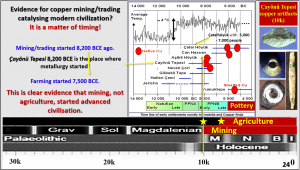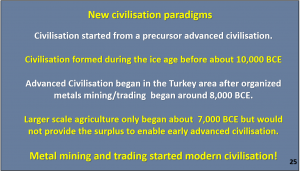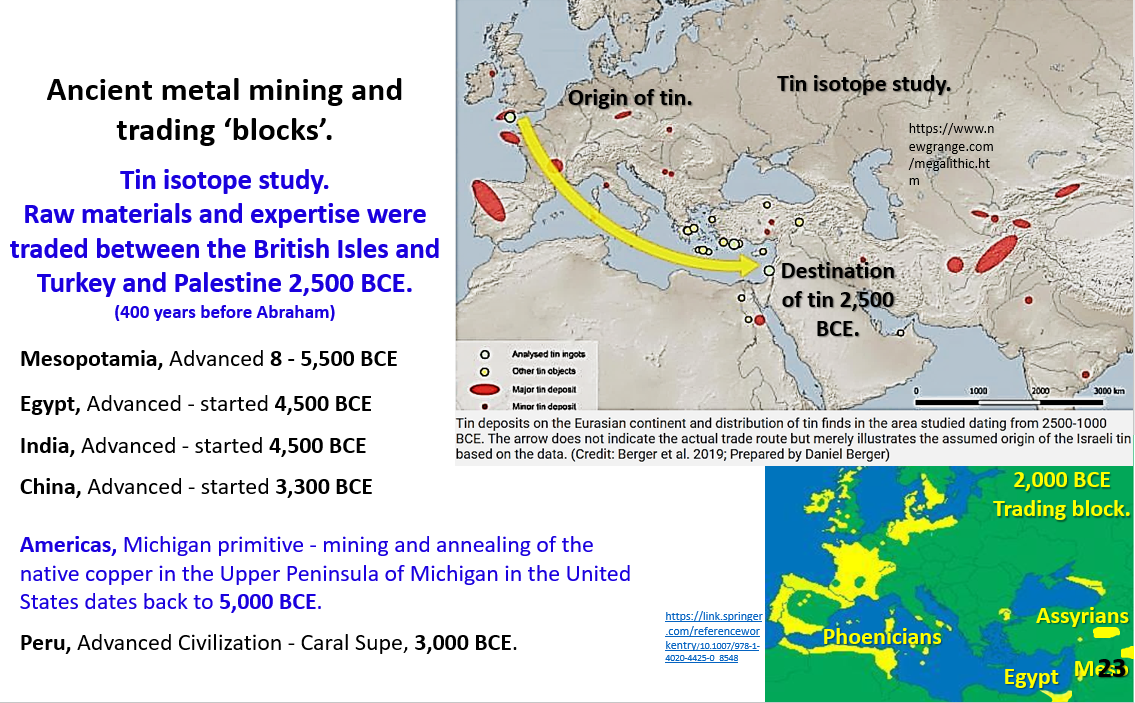Figure 23 – above. Summary of European Bronze Age trading routes and tin isotope study.
We have established that copper mining and trading occurred very early in human civilsation. We also know that widely separated countries traded with each other by the goods they traded. Modern science also shines a light on the spatial relationship of these ancient trading blocks?
Isotope studies show that the tin in Turkey and Palestine came from Cornwall in the British Isles in 2,500 BCE (https://journals.plos.org/plosone/article?id=10.1371/journal.pone.0218326).
Other studies show that tin from Afghanistan and maybe far western China (Central Asia) was imported into the Mesopotamian region within the same time frame, https://www.taylorfrancis.com/chapters/edit/10.4324/9781315193359-34/acquisition-tin-bronze-age-southwest-asia-vincent-pigott .
Copper use was widespread in the Turkey after 8,000 BCE but in general archaeology only really reports its intensive use in Mesopotamia from 4,500 BCE, 4,500 BCE in Egypt, 4,500 BCE in India, 3,300 BCE in China. Thus its very early importance is discounted.
However, even the Americas had mining of native copper in Michigan back to 5,000 BCE (https://www.exploringthenorth.com/cophistory/cophist.html and https://www.exploringthenorth.com/cophistory/cophist.html) and in South America and Central America by 2,000 BCE in_pre-Columbian_America https://en.wikipedia.org/wiki/Metallurgy_ .
Copper mining was universal in the early advanced, urbanised civilisations from the earliest records.

This chart summarises the use of copper in the Gobeklitepe (Harran Plain) area in Turkey and is probably representative of Israel as well.
Native copper has been shown to be used long before this time in a sporadic way but the first industrial scale use of copper in south eastern Europe started between 10,000 and 8,000 BCE.
In fact, by 8,200 BCE larger scale copper smelting and metallurgy had started at Cayonu Tepesi (https://www.tf.uni-kiel.de/matwis/amat/iss/kap_a/advanced/ta_1_2.html).
The artifacts on the right-hand side show the various copper uses such as beads and awls in this area at this time. It can be seen along the bottom time-bar that agriculture did not start on a larger scale until at least 1,500 years later.
This is local chronological evidence that copper mining kickstarted advanced urbanised civilisation (and probably larger scale agriculture).
How rich were these mines that catalysed civilisation?
Their richness will astound you!
Alexander had a gold mine in Macedonia from which he produced over 1,000,000 ounces a year during his lifetime (https://archaeologynewsnetwork.blogspot.com/2018/09/precious-metals-and-rise-of-two.html – Jim Ross paper and personal communication). We think of a 1 million ounce/year gold mine in terms of the Super Pit in Kalgoorlie or the huge underground mines in South Africa. They are the largest gold mines in the world! They are a huge undertaking!
Alexander’s little mine would not rate a mention in size but it would have been thousands of grams per tonne of gold in richness.
This would have been repeated all over the world in ancient times with the rich alluvial gold and other metals lying right on the surface because of weathering.
We tend to discount the importance of mining in the start of civilisation based on the current scarcity of metals right on the surface waiting to be picked up and used. This was not the case 10,000 BCE and must be taken into account in our explorations of civilisations beginnings.
In conclusion this mining and spatial evidence (from parts 1-9 of this discussion) suggests that the following new civilisation paradigms need to be seriously considered and examined.

The surface abundance of copper, gold and other metals, the greedy nature of human beings, the timing relationship between copper mining and the start of civilisation and the later commencement of agriculture all suggest that metal mining and trading were the main catalyst that started modern European civilisation – not agriculture!
The fact that there was avid trading of metals in prehistory suggests metal mining and trading was the main catalysis for widespread modern advanced civilisation and not agriculture. Not only did mining precede agriculture but the then known worldwide trade in metals spread civilisation. I’m sure the commencement of agriculture alone did not promote worldwide trade!!
The next phase of this research examines the structural geological reasons for the close correlation between the ancient henges and temples and the ancient mines.
Cheers
Bob Watchorn

